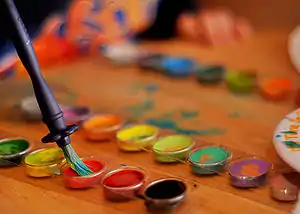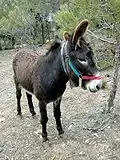< Spanish by Choice







How Do You Spell ‘Beige?’
Introduction
You have a question? Liliana and JP tell us how to ask it. Specifically, they talk about a spelling question; thus, the keyword is be de burro – b as in donkey (b as in Bob).
- related SpanishPod lessons: A0005: Take a picture, A0008: How do you say ...?, A0011: Call me
- discussion: visit the readers' forum for this lesson to discuss it or to ask questions about it
- source: SpanishPod, the original MP3 lesson content of this lesson is licensed by PraxisLanguage Ltd. under a Creative Commons 3.0 Unported license.
 |
 |
Audio Lesson

Dialogue
hombre: Tengo una pregunta. align="right"| mujer: ¡Dime! align="right"| hombre: ¿Cómo se escribe beige? align="right"| mujer: ¿El color? Se escribe con be de burro, e, i, ge, e. align="right"| hombre: Gracias. align="right"|

Dialogue with Translation
hombre: Tengo una pregunta. align="right" valign="top" rowspan="3"| (I) have a question man: I have a question.
mujer: ¡Dime! align="right" valign="top" rowspan="3"| tell me woman: Tell me!
hombre: ¿Cómo se escribe beige? align="right" valign="top" rowspan="3"| how itself/one writes beige man: How do you write beige?
mujer: ¿El color? Se escribe con be de burro, e, i, ge, e. align="right" valign="top" rowspan="3"| the color itself/one writes with b of donkey, e, i, g, e woman: The color? You write it with b as in Bob, e, i, g, e.
hombre: Gracias. align="right" valign="top" rowspan="3"| thanks man: Thanks.

escribir – to write

el color – the color

el burro – the donkey
Vocabulary for Dialogue
el hombre noun (masculine) the man la mujer noun (feminine) the woman tener verb (infinitive) to have (yo) tengo verb (present tense) I have un/una article (m./f.) a la pregunta noun (feminine) the question decir verb (infinitive) to say ¡(tú) di! verb (imperative) (you) say! (informal, singular) me indirect object pronoun (to) me ¡dime! phrase tell me! ¿cómo? adverb how? se reflexive pronoun itself, one, you escribir verb (infinitive) to write (él/ella) escribe verb (present tense) he/she(/it) writes beige adjective (m./f.) beige el color noun (masculine) the color con preposition with de preposition of el burro noun (masculine) the donkey la be de burro phrase the b as in donkey la e noun (feminine) the e la i noun (feminine) the i la ge noun (feminine) the g gracias phrase thanks
Vocabulary for Audio Lesson
¿Cómo se escribe? phrase How do you write? la a noun (feminine) the a la ce noun (feminine) the c la ere noun (feminine) the r la ese noun (feminine) the s Parangaricutirimícuaro noun (masculine) a tongue twister

More Vocabulary
This section includes grammatically related words. Some of them are required by the exercise Dialogue Recast.
| tener | infinitive | to have |
| (yo) tengo | present tense | I have |
| (tú) tienes | you have (informal, singular) | |
| (él/ella) tiene | he/she(/it) has | |
| (usted) tiene | you have (formal, singular) | |
| (nosotros/-as) tenemos | we have (m./f.) | |
| (vosotros/-as) tenéis | you have (informal, plural, m./f.) | |
| (ellos/ellas) tienen | they have (m./f.) | |
| (ustedes) tienen | you have (formal, plural) | |
| decir | infinitive | to say |
| ¡(tú) di! | imperative | (you) say! (informal, singular) |
| ¡(usted) diga! | (you) say! (formal, singular) | |
| ¡(nosotros/-as) digamos! | (let's) say! (m./f.) | |
| ¡(vosotros/-as) decid! | (you) say! (informal, plural, m./f.) | |
| ¡(ustedes) digan! | (you) say! (formal, plural) | |
| me | indirect object pronoun | (to) me |
| te | (to) you (informal, singular) | |
| le | (to) him/her(/it) | |
| le | (to) you (formal, singular) | |
| nos | (to) us | |
| os | (to) you (informal, plural) | |
| les | (to) them | |
| les | (to) you (formal, plural) | |
| escribir | infinitive | to write |
| (yo) escribo | present tense | I write |
| (tú) escribes | you write (informal, singular) | |
| (él/ella) escribe | he/she(/it) writes | |
| (usted) escribe | you write (formal, singular) | |
| (nosotros/-as) escribimos | we write (m./f.) | |
| (vosotros/-as) escribís | you write (informal, plural, m./f.) | |
| (ellos/ellas) escriben | they write (m./f.) | |
| (ustedes) escriben | you write (formal, plural) | |
| a, be, ce, che, de, e, | noun (feminine) | letters from a to z |
| efe, ge, hache, i, jota, | ||
| ka, ele, elle, eme, ene, eñe, | ||
| o, pe, cu, ere, ese, te, | ||
| u, ve, doble ve, | ||
| equis, i griega, zeta | ||

Exercises
Dialogue Translation
Translate from Spanish to English. Click each bar to check your answer. If possible, read the Spanish sentences aloud.
Tengo una pregunta.
I have a question.
¡Dime!
Tell me!
¿Cómo se escribe beige?
How do you write beige?
¿El color? Se escribe con be de burro, e, i, ge, e.
The color? You write it with b as in Bob, e, i, g, e.
Gracias.
Thanks.
Dialogue Recall
Now translate from English to Spanish. Remember to say the Spanish sentences aloud.
I have a question.
Tengo una pregunta.
Tell me!
¡Dime!
How do you write beige?
¿Cómo se escribe beige?
The color? You write it with b as in Bob, e, i, g, e.
¿El color? Se escribe con be de burro, e, i, ge, e.
Thanks.
Gracias.
Dialogue Remix
Translate this variant of the dialogue from English to Spanish.
Tell me a question!
¡Dime una pregunta!
I have one.
Tengo una.
Tell me!
¡Dime!
How do you write escribir?
¿Cómo se escribe escribir?
One writes e, s, c, r, i, b, i, r.
Se escribe e, ese, ce, ere, i, be de burro, i, ere.
Thanks.
Gracias.
Dialogue Recast
This translation exercise requires some of the words from the More Vocabulary section.
We have a question.
Tenemos una pregunta.
You tell me! (formal, plural)
¡Díganme!
How do you write beige?
¿Cómo se escribe beige?
The color? You write it with b as in Bob, e, i, g, e.
¿El color? Se escribe con be de burro, e, i, ge, e.
Thanks.
Gracias.
| ← previous: lesson A0016 | ↑ current: lesson A0019 | ↑↑ index: SpanishPod lessons | next: lesson A0021 → |
This article is issued from Wikibooks. The text is licensed under Creative Commons - Attribution - Sharealike. Additional terms may apply for the media files.